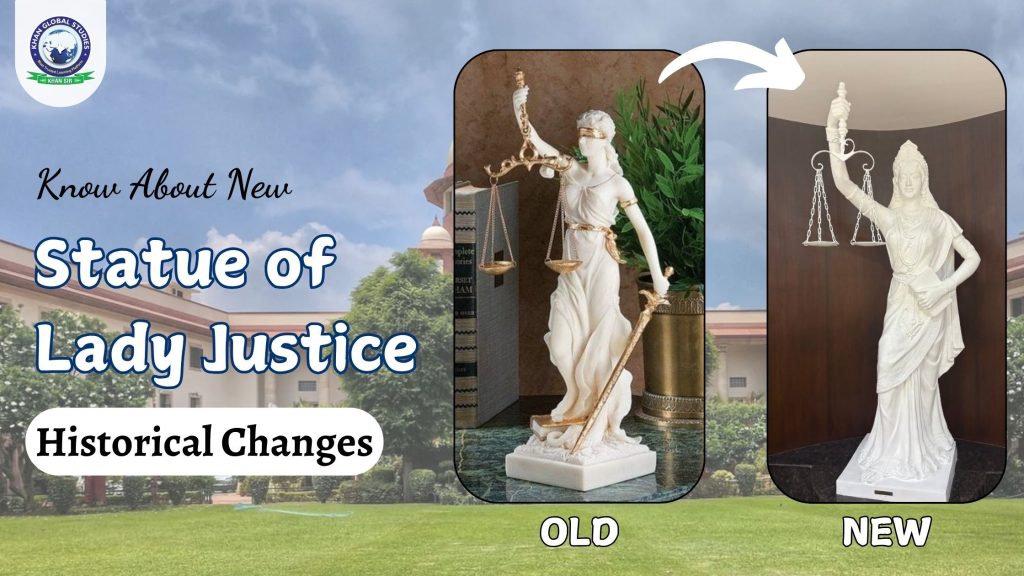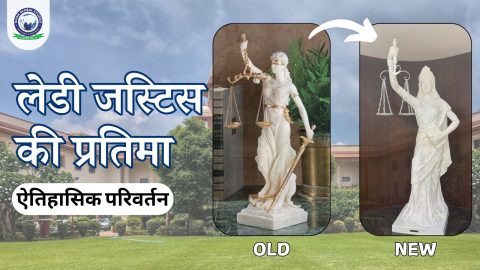Lady Justice, often identified by her blindfold, scales, and sword, is an enduring symbol of fairness and equality. Representing the concept of impartial justice, her image is revered globally. Over the centuries, her depiction has undergone cultural and ideological changes, reflecting societal values.
Historical Background
Origins in Roman Mythology
Lady Justice’s roots are linked to the Roman goddess Justitia. Depicted with a sword and scales, she symbolized both fairness and authority. The Renaissance further refined her image, incorporating the blindfold as a critique of judicial corruption, which was later reinterpreted as impartiality.
Key Elements of Lady Justice
- Blindfold: A symbol of neutrality, added later. Initially seen as satirical, it evolved into a symbol of impartiality.
- Scales: Reflects the principle of balance and impartially weighing evidence.
- Sword: Represents the power of the law to enforce justice or punish.
Colonial Influences on Lady Justice in India
During British rule, the statue of Lady Justice became a permanent fixture outside Indian courtrooms. It was a symbol of the imposition of Western legal standards, which affected India’s native judicial traditions.
New Lady Justice Statue in India
Recently unveiled by the Chief Justice of India, the new statue depicts Lady Justice wearing a sari, holding the Constitution in one hand and the scales in the other. The absence of a blindfold and the emphasis on visibility underscore the need for context-sensitive adjudication in a diverse society.
Decolonization of Judicial Symbols
Replacing the colonial-era statue reflects India’s journey of decolonization. The sari connects Justice to Indian traditions, while the Constitution replaces the sword, reflecting its centrality in India’s legal framework.
Symbolic Changes in the New Statue
- Sari: Symbolizes Indian cultural values.
- No blindfold: Symbolizes transparency and the need to consider diversity in judicial decisions.
- Constitution: Replaces the sword, highlighting its supreme power.
Public Reception and Debate
The new statue has sparked widespread debate. Supporters applaud its anti-colonial message, while critics argue about replacing a global symbol. This dialogue reflects broader aspirations for judicial reforms.
Role of the Constitution in Indian Justice
The Indian Constitution is the ultimate guide for ensuring equality and justice. By placing it at the core of the judicial symbol, the new statute emphasises its importance in legal decisions.
Addressing Systemic Delays in Justice
Pending Cases and Judicial Backlog
With over 5 crore pending cases, delays undermine public confidence in the system.
Strategies for reform
- Introducing technology in case management.
- Increasing judicial manpower.
Reforming Judicial Appointments
- Streamlining the MoP: The memorandum of procedure needs to be urgently finalised to improve transparency.
- Enhancing Diversity: Representation of women and marginalised groups is crucial for inclusive justice.
Improving Representation in the Judiciary
- Gender imbalance: Women constitute less than 15% of the higher judiciary.
- Inclusivity: Efforts are needed to increase representation from SC, ST and OBC communities.
Filling Judicial Vacancies
India’s high courts operate at 60-70% capacity, leading to delays in cases. Quick action is needed to fill these gaps.
Prioritising Constitutional Matters
Cases involving constitutional amendments or personal liberties must be dealt with swiftly to uphold democratic principles.
Conclusion: Justice and its Indian Identity
India’s new Lady Justice embodies an evolving judicial identity – balancing traditional values with modern imperatives. By rooting justice in Indian culture and constitutional supremacy, it paves the way for an equitable future.
Frequently Asked Questions
Q: Why was the new Lady Justice statue introduced in India?
Ans: To represent India’s cultural values and move away from the colonial image.
Q: What does it mean to not wear a blindfold?
Ans: It emphasises transparency and context-sensitive justice.
Q: How does the Constitution replace the sword in the new statute?
Ans: It highlights the supreme authority of the Constitution in Indian law.
Q: What are the challenges facing India’s judiciary?
Ans: Judicial delays, vacancies and lack of diversity are major concerns.
Q: What steps can be taken to improve justice delivery in India?
Ans: Case management, judicial appointments and prioritization of cases need to be improved.
Q: How does the new statue reflect anti-colonial sentiment?
Ans: By adopting Indian cultural elements and emphasizing the supremacy of the Constitution.
Also Read:
- Constitution Day of India: History, Timeline and Importance
- Article 370 of the Indian Constitution: History and Abrogate




